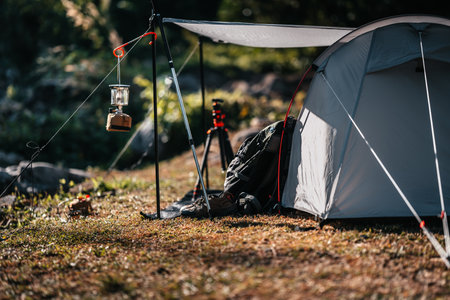1. Understanding the Importance of Staying Warm
Winter camping can be an incredible adventure, offering quiet trails, peaceful landscapes, and fewer crowds. But with all its beauty comes one major challenge: staying warm. When temperatures drop, your body becomes more vulnerable to cold-related dangers like hypothermia and frostbite. That’s why managing warmth isn’t just about comfort—it’s essential for safety.
Why Cold Weather Poses a Serious Risk
Cold exposure can quickly become dangerous if youre not properly prepared. Here are two of the biggest risks:
| Condition | Description | Warning Signs |
|---|---|---|
| Hypothermia | This happens when your body loses heat faster than it can produce it, causing your core temperature to drop below 95°F (35°C). | Shivering, confusion, slurred speech, fatigue |
| Frostbite | A condition where skin and underlying tissues freeze due to extreme cold, often affecting fingers, toes, nose, and ears. | Numbness, white or grayish skin, hard or waxy feel |
The Role of Proper Warmth Management
Staying warm is more than just bundling up—its about being smart with your layers, choosing the right gear, and creating a reliable shelter setup. Good warmth management helps regulate your body temperature, keeps moisture away from your skin, and protects you from wind and snow. When done right, it allows you to enjoy your trip without putting yourself at risk.
Benefits of Staying Warm While Camping in Winter
- Safety: Avoids life-threatening conditions like hypothermia and frostbite.
- Comfort: Helps you sleep better and move around more freely.
- Energy Conservation: Your body won’t have to work as hard to stay warm.
- Mental Clarity: Cold can affect decision-making; warmth keeps your mind sharp.
Key Takeaway
Understanding how cold affects your body is the first step to preparing for winter camping. With the right knowledge and preparation, you can stay safe and enjoy everything the snowy outdoors has to offer.
2. Mastering the Art of Layering
When it comes to staying warm during winter camping, dressing in layers is your best defense against the cold. The key is to build a clothing system that traps heat, wicks away moisture, and blocks wind and snow — all while giving you flexibility to adjust as your activity level changes.
Understanding the Three-Layer System
The three-layer approach helps regulate body temperature and keeps you dry from both sweat and snow. Heres a quick breakdown of each layer:
| Layer | Purpose | Recommended Materials |
|---|---|---|
| Base Layer | Wicks moisture away from skin | Merino wool, synthetic fabrics (like polyester) |
| Mid Layer | Traps body heat for insulation | Fleece, down, or synthetic insulated jackets |
| Outer Layer (Shell) | Protects against wind, rain, and snow | Waterproof breathable shells (like Gore-Tex) |
Tips for Choosing the Right Layers
Base Layer Tips
- Avoid cotton — it holds moisture and can make you cold.
- Choose snug-fitting tops and bottoms that wick sweat away quickly.
Mid Layer Tips
- Add or remove this layer based on your activity level.
- If youre sitting around camp more than hiking, go with a thicker insulated option.
Outer Layer Tips
- Your shell should be windproof and waterproof but still breathable.
- Pit zips or ventilation panels help release excess heat when youre moving.
Layering for Different Activities
Your layering needs can change depending on what you’re doing. Here’s how to adapt:
| Activity Level | Recommended Layering Strategy |
|---|---|
| High (e.g., hiking uphill) | Lighter mid-layer or just base + shell to prevent overheating; vent frequently. |
| Moderate (e.g., setting up camp) | Full three-layer system; adjust mid-layer thickness based on temps. |
| Low (e.g., sitting around the fire) | Add extra insulation like a puffy jacket or insulated pants over your base setup. |
Don’t Forget Accessories!
Your extremities lose heat fast, so don’t skimp on gear like hats, gloves, socks, and insulated boots. Consider layering here too — thin liner gloves under thick mittens work great, and wearing two pairs of socks (liner + wool) can help keep your feet dry and warm without cutting off circulation.
Pro Tip:
If you start feeling sweaty, shed a layer before you get soaked. Staying dry is just as important as staying warm when youre out in the backcountry during winter.

3. Choosing the Right Winter Camping Gear
When it comes to winter camping, having the right gear can mean the difference between a cozy night under the stars and a miserable, freezing experience. Heres what you need to stay warm and safe in cold conditions.
Cold-Rated Sleeping Bags
A high-quality sleeping bag rated for sub-zero temperatures is essential. Look for bags with a temperature rating at least 10°F lower than the expected nighttime temps. Down insulation is lighter and more compressible, while synthetic insulation performs better in damp conditions.
Sleeping Bag Comparison Table
| Feature | Down Sleeping Bag | Synthetic Sleeping Bag |
|---|---|---|
| Warmth-to-Weight Ratio | Excellent | Good |
| Performance When Wet | Poor | Better |
| Compressibility | High | Moderate |
Insulated Sleeping Pads
The ground can drain body heat quickly, so don’t overlook your sleeping pad. Look for pads with a high R-value (5 or above) to provide insulation from the cold ground. Many campers double up with a foam pad underneath an inflatable one for extra warmth.
Four-Season Tents
A four-season tent is built to handle snow loads, strong winds, and low temperatures. Unlike three-season tents, these shelters have stronger poles, fewer mesh panels, and better wind protection. Make sure your tent has good ventilation to reduce condensation buildup inside.
Weather-Appropriate Clothing
Dressing properly starts with base layers that wick moisture, mid-layers like fleece or down for insulation, and outer layers that block wind and moisture. Don’t forget accessories—warm hats, gloves, thick socks, and insulated boots are just as critical.
Winter Clothing Essentials Checklist
- Moisture-wicking base layer (top and bottom)
- Insulating mid-layer (fleece or down jacket)
- Waterproof/windproof outer shell (jacket and pants)
- Wool or synthetic socks (multiple pairs)
- Insulated winter boots with good traction
- Warm beanie or hat that covers ears
- Gloves or mittens (water-resistant if possible)
- Neck gaiter or balaclava for face protection
Having the right gear not only keeps you warm but also helps you enjoy your winter camping trip without constantly worrying about the cold. Investing in quality equipment tailored for winter use is well worth it when youre out braving the elements.
4. Shelter Setup and Site Selection Tips
Choosing the right campsite and setting up your shelter properly are key steps to staying warm while winter camping. A well-chosen location and a smart setup can protect you from wind, conserve heat, and help you sleep comfortably through cold nights. Here’s how to do it right:
Pick the Right Spot
When selecting your campsite in winter, look for natural features that offer protection from the elements. Avoid low-lying areas where cold air settles overnight, and steer clear of open ridges where wind exposure is highest.
| Do | Dont |
|---|---|
| Camp near tree lines or behind natural windbreaks like boulders | Set up camp in valleys or exposed ridgelines |
| Choose flat ground with firm snow for stability | Camp under heavy snow-laden branches (risk of falling snow) |
Set Up Your Tent With Warmth in Mind
How you pitch your tent can make a big difference in warmth. Position your tent so that the smallest side faces into the wind to reduce exposure. Use guy lines to secure it tightly—winter winds can be strong.
Add Wind Protection
If there’s no natural windbreak, build one using snow walls or by stacking gear like backpacks on the windward side. This helps cut down on wind chill inside your shelter.
Use Ground Insulation
The cold ground can drain body heat quickly. Always use an insulating layer between your sleeping pad and the snow or frozen soil. Combining foam and inflatable pads works best for winter conditions.
| Insulation Type | Benefits |
|---|---|
| Closed-cell foam pad | Lightweight, durable, adds insulation from ground |
| Inflatable pad with high R-value | Comfortable, excellent thermal insulation |
| Layered combo (foam + inflatable) | Best overall warmth and comfort for winter camping |
Add Heat-Reflective Elements
You can boost warmth inside your tent by reflecting body heat back at you. Use a mylar emergency blanket or reflective tarp underneath your sleeping area or hung inside the tent walls. Just make sure theres ventilation to avoid condensation buildup.
Quick Tip:
A small candle lantern (used safely) or heated water bottle placed inside your sleeping bag can also add noticeable warmth during freezing nights.
With smart site selection and a well-prepared shelter setup, youll be much more comfortable braving those chilly winter nights outdoors.
5. Smart Habits to Stay Warm Overnight
Staying warm while winter camping isn’t just about having the right gear — your nighttime habits can make a huge difference too. Here are some smart tips to help you stay cozy from sundown to sunrise, even when temperatures drop well below freezing.
Eat a High-Fat Snack Before Bed
Your body needs fuel to generate heat during the night. Eating a high-fat snack before bedtime gives your metabolism something to work on while you sleep, helping to keep you warm. Think of it like tossing a log into a fire before turning in for the night.
| Snack Idea | Why It Works |
|---|---|
| Peanut butter on crackers | High in fat and easy to digest |
| Trail mix with nuts and chocolate | Fat, protein, and sugar for long-lasting energy |
| Cheese cubes or jerky | Savory options with solid fat content |
Keep Your Gear Dry
Damp clothing or sleeping bags can rob your body of heat quickly. Always change out of sweaty base layers before going to bed, even if it feels cold at first. Store wet boots or gloves outside your sleeping area in a waterproof bag so they don’t add moisture inside your tent.
Pro Tip:
If your socks are damp, swap them out for a dry pair dedicated just for sleeping. Keep them tucked inside your sleeping bag during the day so theyre warm when you need them.
Use a Hot Water Bottle Inside Your Sleeping Bag
This classic trick works wonders: fill a durable water bottle with hot (but not boiling) water and toss it into your sleeping bag before crawling in. Place it near your core, between your thighs, or at your feet—wherever you feel coldest.
Hot Water Bottle Tips:
- Use a leak-proof bottle like a Nalgene (avoid flimsy plastic).
- Wrap it in a sock or bandana to prevent burns and extend warmth.
- If youre backpacking, this doubles as a warm-up tool for hands in the morning.
Insulate Yourself from the Ground
No matter how warm your sleeping bag is, if you’re losing heat to the ground, you’ll wake up cold. Always use an insulated sleeping pad — or better yet, double up with a foam pad underneath an inflatable one for maximum protection against heat loss.
Avoid Breathing Into Your Sleeping Bag
It might seem natural to snuggle all the way into your bag, but breathing inside introduces moisture that can make insulation less effective. Instead, cinch down the hood around your face and keep your nose and mouth outside the bag.
Bonus Tip:
If condensation is still an issue inside your tent, crack open a vent or leave a small gap in the zipper to allow airflow without letting in too much cold air.
Stay Active Until Bedtime
A quick round of jumping jacks or brisk walking before bed can raise your body temperature and help you warm up your sleeping bag faster once inside. Just be sure not to break a sweat — light activity is key.
These small changes in behavior can have a big impact on how well you sleep during frigid nights outdoors. Combine them with proper layering and quality gear to stay warm and comfortable no matter how low the temperature drops.


